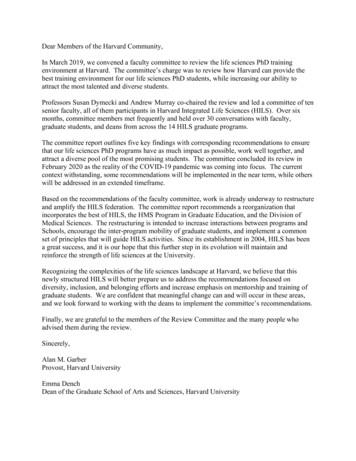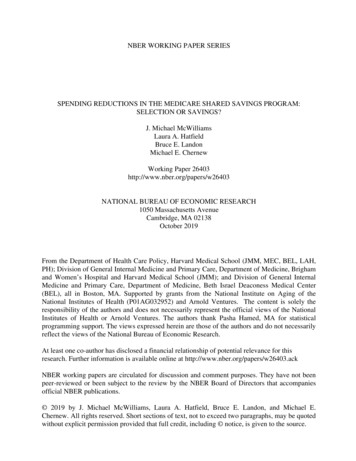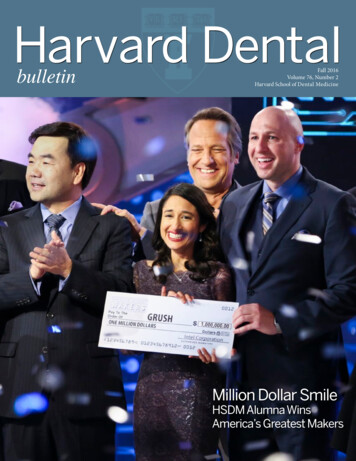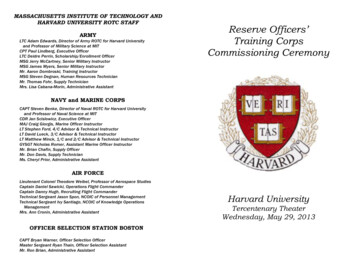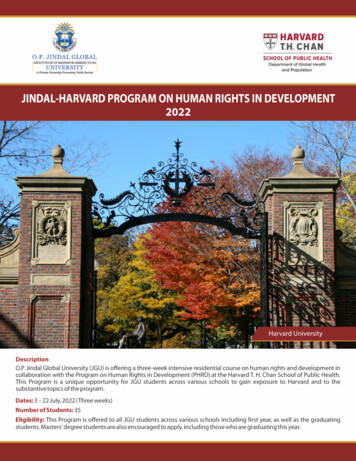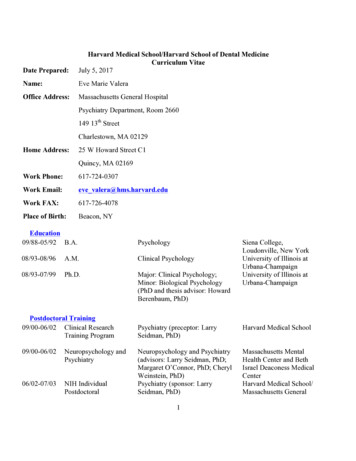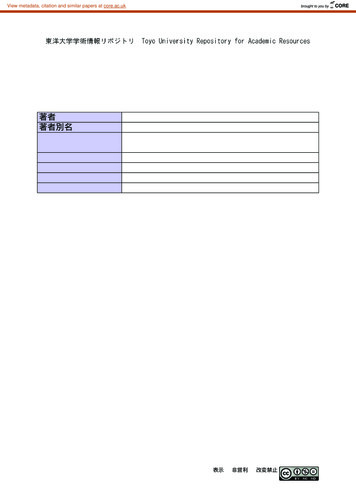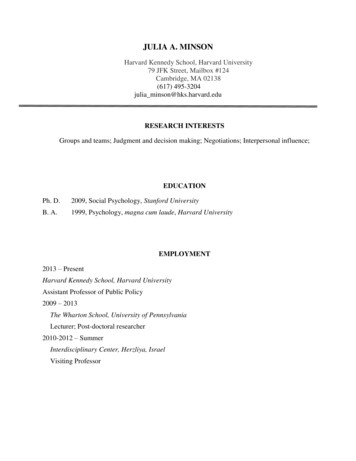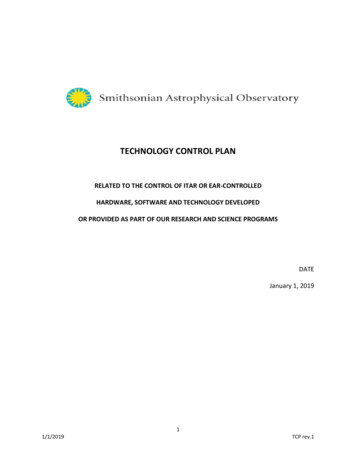
Transcription
TECHNOLOGY CONTROL PLANRELATED TO THE CONTROL OF ITAR OR EAR-CONTROLLEDHARDWARE, SOFTWARE AND TECHNOLOGY DEVELOPEDOR PROVIDED AS PART OF OUR RESEARCH AND SCIENCE PROGRAMSDATEJanuary 1, 201911/1/2019TCP rev.1
Table of Contentsi Definitions . 3ii References . 6Government Links . 61.0. Introduction . 71.1 Our Responsibility . 81.2 Export . 91.3 Scope . 111.4 SAO Facilities . 112.0 Export Compliance Oversight Team. 143.0 CONTROLS UNDER THE TCP . 183.1 Identification of ITAR- or EAR-controlled Programs . 183.2 Policy for Controls over Visitors, Non-US- person Employees, Smithsonian Affiliated Persons andContractors . 303.3 IT Security on Networks, Laptops, Mobile Devices . 474.0 Procurement Controls and Import Screening Process . 505.0 Employee Training . 536.0 Obtaining Approval to Release Technical Data to Non-U.S. Persons . 55Appendix to Technology Control Plan . 62Appendix 3.2.a – Information Form for SAO Staff and Affiliated Persons Who Plan to Collaborate withNon-U.S. Persons on Export-Controlled Projects. 62Appendix 3.2.b Non-Disclosure Agreement: Letter of Assurance for Non-U.S. “SAO-Affiliated Person”*To Permit Access to EAR-Controlled “Technology and Software Under Restriction” (TSR) . 64Appendix 3.3.a Persons subject to SD 931 and Mobile Device Policies including Supplemental ExportCompliance Procedures for Travel with Mobile Devices & Research Equipment . 65Appendix 6.0.a Technology Control Plan Form. 67Appendix 6.0.b Description of Technology Export Controls . 7121/1/2019TCP rev.1
i DefinitionsAlien: Any person who is not a citizen or national of the United States.Bureau of Industry and Security (BIS): Organization within the Department of Commerce that managesexport controls - works with Department of Defense and Department of State to ensure exportcompliance.Controlled Unclassified Information (CUI): Information that is related to defense articles or services onthe U.S. Munitions List, or dual-use strategic items on the Commerce Control List that require an exportlicense to transfer to a non-U.S. person or entity where no license exemption or license exceptionapplies.Deemed Export — Transfer of controlled technology through any means (verbal, written, visual,electronic) to a foreign person in the United States, where a license is required to export the sametechnology to his or her home country.Defense Article — Any item on the U.S. Munitions List (22 CFR, Part 121), and can include nonmilitary items; (e.g., spacecraft, research satellites, certain ground control and infrared technologies)or items specially designed to improve an item’s defense capabilities.Directorate Defense Trade Controls (DDTC): Organization within Department of State that is responsiblefor managing ITAR .Dual-Use — Items and technology that are primarily commercial in nature, but that theGovernment has deemed may have a “dual use” for a military or strategic purpose.Empowered Official (EO): Officer of the company who is trained in the ITAR and signs licenseapplications once the accuracy has been assured. The EO has the authority to legally bind the companyand can halt export shipments without negative repercussions.Export: For the purposes of the TCP, sending or taking export-controlled articles outside the UnitedStates--or the transfer or disclosure of export-controlled articles or technical data--to a non-U.S. personor entity by any means, whether in the U.S. or abroad.Export Administration Regulations (EAR): U.S. Department of Commerce guidelines for control ofexports.Foreign person/Non-U.S. Person: Any person who is not a U.S. citizen, permanent resident alien (greencard holder), or protected individual (refugee and asylum status) as defined in 8 USC 1324b. Thisincludes foreign corporations or partnerships that are not incorporated in the U.S. In this TCP, this is alsoreferred to as a “non-U.S. person”.31/1/2019TCP rev.1
Fundamental Research: Basic and applied research in science and engineering where the resultinginformation is free from restrictions on publication and involves information that is not subject toany access or dissemination controls whose intent is to be published and shared broadly in thescientific community (ITAR, 22 CFR, Section 120.11). The EAR has specific criteria about how the“sharing” must occur to qualify as “publicly available.”Fundamental research is exempt from export controls (although not necessarily outside the scope ofU.S.-imposed trade sanctions). Note: If the research involves the development of or improvement toa tangible item, such as an instrument, and the instrument is on one of the export control lists, it willnot qualify as fundamental research. Procedures exist to obtain permission in writing to releaseinformation into the public domain.International Traffic in Arms Regulations (ITAR): Implementation of the President’s authority tomanage the export of defense articles.National Security Program Operations Manual (NISPOM): Required control plan for companies that areworking on classified projects.Permanent Resident Alien: Person with permanent resident statusPublic Domain Exclusion (ITAR, EAR) — The export control laws contain exceptions from the licensingrequirement for certain information that is in the “public domain,” which means “information that ispublished and that is generally accessible or available to the public.” Note that the EAR and the ITARhandle publications with different criteria. The EAR require that the information has been publishedand the Department of Commerce recognizes “publishing” as posting on the Internet for free. TheITAR require that the information has been published in more limited areas: ordinary publicationthrough sales at newsstands and bookstores; subscriptions which are available, without restriction, atlibraries open to the public; patent information available at any patent office; unlimited distribution ata conference, meeting, seminar, trade show, or exhibition generally accessible to the public, in theUnited States; or public release in any form after approval by the cognizant U.S. Governmentdepartment or agency.Information which is published and which is generally accessible or available to the public:(1) Through sales at newsstands and bookstores;(2) Through subscriptions which are available without restriction to any individual who desires toobtain or purchase the published information;(3) Through second class mailing privileges granted by the U.S. Government;(4) At libraries open to the public or from which the public can obtain documents;(5) Through patents available at any patent office;(6) Through unlimited distribution at a conference, meeting, seminar, trade show or exhibition,generally accessible to the public, in the United States;(7) Through public release (i.e., unlimited distribution) in any form (e.g., not necessarily in publishedform) after approval by the cognizant U.S. Government department or agency(see also41/1/2019TCP rev.1
§ 125.4(b)(13) of this subchapter);(8) Through fundamental research in science and engineering at accredited institutions of higherlearning in the U.S. where the resulting information is ordinarily published and shared broadly inthe scientific community. Fundamental research is defined in previous section.Smithsonian-Affiliated Persons (SAO-Affiliated Persons)— this category includes contractors embeddedwith SI employees, research associates, interns and Fellows, volunteers, and visitingresearchers(including scientists, scholars and students).Technical Assistance Agreement (TAA): Agreement provided by DDTC to allow specified foreign entitiesworkers to allow access to specified ITAR information.Technical Data: Any information related to the development, design, manufacture, servicing, or repairof a controlled item.Technology Control Plan (TCP): Plan implemented by companies that design or develop ITAR-controlledtechnology--or that access the ITAR-controlled information of their clients--to safeguard against theunauthorized release of ITAR technology and information to Non-U.S. persons that follow the guidelinesprovided by the DDTC and the NISPOM recommendations for classified projects.U.S. Munitions List: Part of the secondary regulations in the ITAR that defines which defense articlesand services are subject to licensing. The list is contained in part 121 of ITAR (22 Code of FederalReguations (CFR) Parts 120 – 130) and is divided into 24 categories.U.S. Person: A person who is a United States citizen, lawful permanent resident alien, or who is aprotected individual (refugee or asylum status).51/1/2019TCP rev.1
ii References ce-linksGovernment Linksa. Bureau of Industry and Security web pagei.FAQs on exportingii. Export Administration Regulation (EAR) – downloadable filesiii. Commerce Control Listiv. Alphabetical Index to CCLv. Countries under EAR export restrictionsvi. Multilateral Export Control Regimesb. Directorate of Defense Trade Controlsi. International Traffic in Arms Regulationsii. Glossary of Termsiii. Proscribed Countriesiv. US Munitions Listv. Commodity Jurisdictionvi. Order of Reviewvii. Specially Designed Tool61/1/2019TCP rev.1
1.0. IntroductionAs a research institution, the Smithsonian Astrophysical Observatory (SAO) is required by federal law tosafeguard and/or obtain approval for the transfer of hardware, software and technical data to non-U.S.persons for space and export -controlled projects that are outside of the “fundamental research” or“public domain” parameters.The Technology Control Plan (TCP) and its implementation is our compliance system used to control theaccess to export-controlled data, software and technology to non-U.S. persons. SAO follows guidelinesissued by several government agencies, including NASA, describing best practices for establishingadequate TCPs.These guidelines require that “exporters” of export-controlled information have methods in place toprevent access to controlled technology by non-U.S. persons until authorization can be obtained. Inaddition to an actual shipment of a tangible article or transmission of data, an “export”, defined in thefollowing section, could also be a tour, meeting, training, webinar, email, download, traveling with amobile device with export-controlled data or allowing access to a network when non-U.S. person areinvolved.The TCP exerts controls in four areas:1. Physical access controls related to monitoring of visitors and non-U.S. workers to research spacesand offices where export-controlled work is being performed or export-controlled instruments arelocated.2. Human Resource (HR) controls to assess the U.S.-person status of job candidates, employees andcontractors who may need access to CUI as part of their responsibilities and communicate thisstatus to the Export Compliance Officer3. Information Technology controls that are designed to limit access to export-controlled informationand monitor networks and servers from intrusion.4. Procurement controls to ensure that technical specifications and export-controlled drawings areproperly marked and reviewed for license requirements before they are provided to vendors andcontractors/subcontractors.This document describes SAO’s procedures and training in these areas.The NASA Handbook and other references can be found on the SAO Export Compliance website .71/1/2019TCP rev.1
1.1 Our ResponsibilitiesWe are responsible for identifying projects that may have “foreign national” or export restrictions andanalyzing which activities subject SAO to the controls of the International Traffic In Arms Regulations (ITAR) (22 CFR Parts 120 – 130) which areadministered by the U.S. Dept. of State, Directorate of Defense Trade Controls (DDTC). Theseregulations control the export of space and infrared technologies; satellites, space vehicles,ground stations; and encryption for military use and guidance systems, among other speciallydesigned defense items. We must interface with DDTC when obtaining approval for technologytransfers. Export Administration Regulations (EAR) (15 CFR Parts 730 – 774) which regulate all othercommercial items that are exported, including some items that may require a license from theU.S. Dept. of Commerce, Bureau of Industry and Security (BIS). Items that may need a licenseare lower-level IR cameras, some cryo-cooled optics and lasers, as well as items, software andtechnology which may not require an export license, but are subject to foreign policy, terrorist,and weapons of mass destruction export restrictions. Foreign Assets Control Regulations (FACR) There are many countries that are under UnitedNations (UN) sanctions or U.S. foreign policy sanctions. Even if a license is not required totransfer certain items, such as copyrighted material, SAO may not transfer export-controlledtechnology or any monetary assets to these countries or to officials of those countries that arelisted on the Specially Designated Nationals List or from Cuba, Iran, North Korea, Sudan andSyria.The SAO Export Compliance Officer (ECO) and the Export Compliance Oversight Team are personsdelegated as responsible for the day-to-day export/import operations and compliance oversight relatedto Sponsored Programs, Information Technology (IT), Facilities, Engineering, Property Management,Procurement, Travel and HR.The SAO ECO responds to inquiries, determines what type of export license is required, and applies forthe appropriate license. The ECO identifies and reviews export-controlled projects/items/technical datahandled by SAO; manages licenses and compliance with export license provisos, Non-DisclosureAgreement (NDAs) and record keeping requirements; and prepares all necessary Technical AssistanceAgreements (TAAs) and related documents, as necessary.These inquiries include: Does my project/contract have export control restrictions? Do I need approval to hire or collaborate with a non-U.S. person?81/1/2019TCP rev.1
Are there concerns about presenting my research to an audience where foreign persons maybe present? Can I provide design information to a foreign vendor? What am I responsible for when securing my lab space? Now that I have a license, what do I need to do? What records do I need to keep? What do I need to do to export an item or hand-carry my laptop or mobile device overseas?The persons who are involved with releasing technical data need to be informed that “export” is broadlyapplied in U.S. export regulations. The definition is below:1.2 ExportPer the ITAR § 120.17, an Export means(a) Except as set forth in §126.16 or §126.17, export means:(1) An actual shipment or transmission out of the United States, including the sending or taking ofa defense article out of the United States in any manner;(2) Releasing or otherwise transferring technical data to a foreign person in the United States (a“deemed export”);(3) Transferring registration, control, or ownership of any aircraft, vessel, or satellite subject to theITAR by a U.S. person to a foreign person;(4) Releasing or otherwise transferring a defense article to an embassy or to any of its agencies orsubdivisions, such as a diplomatic mission or consulate, in the United States;(5) Performing a defense service on behalf of, or for the benefit of, a foreign person, whether inthe United States or abroad; or(6) A launch vehicle or payload shall not, by reason of the launching of such vehicle, be consideredan export for purposes of this subchapter. However, for certain limited purposes (see §126.1 of thissubchapter), the controls of this subchapter may apply to any sale, transfer or proposal to sell ortransfer defense articles or defense services.(b) Any release in the United States of technical data to a foreign person is deemed to be an export to allcountries in which the foreign person has held or holds citizenship or holds permanent residency.Per the EAR §734.13:(a) Except as set forth in §§ 734.17 or 734.18, Export means:91/1/2019TCP rev.1
(1) An actual shipment or transmission out of the United States, including the sending or takingof an item out of the United States, in any manner;(2) Releasing or otherwise transferring “technology” or source code (but not object code) to aforeign person in the United States (a “deemed export”);(3) Transferring by a person in the United States of registration, control, or ownership of:(i) A spacecraft subject to the EAR that is not eligible for export under LicenseException Strategic Trade Authorization (740.20) STA (i.e., spacecraft thatprovide space-based logistics, assembly or servicing of any spacecraft) to aperson in or a national of any other country; or(ii) Any other spacecraft subject to the EAR to a person in or a national of aCountry Group D:5 country.(b) Any release in the United States of “technology” or source code to a foreign person is adeemed export to the foreign person's most recent country of citizenship or permanentresidency.(c) The export of an item that will transit through a country or countries to a destinationidentified in the EAR is deemed to be an export to that destination.§ 734.17 relates to the export of encryption source code and 734.18 relates to what is not an export:(1) Launching a spacecraft, launch vehicle, payload, or other item into space.(2) Transmitting or otherwise transferring “technology” or “software” to a person in the UnitedStates who is not a foreign person from another person in the United States.(3) Transmitting or otherwise making a transfer (in-country) within the same foreign country of“technology” or “software” between or among only persons who are not “foreign persons,” solong as the transmission or transfer does not result in a release to a foreign person or to aperson prohibited from receiving the “technology” or “software.”(4) Shipping, moving, or transferring items between or among the United States, the District ofColumbia, the Commonwealth of Puerto Rico, or the Commonwealth of the Northern MarianaIslands or any territory, dependency, or possession of the United States as listed in Schedule C,Classification Codes and Descriptions for U.S. Export Statistics, issued by the Bureau of theCensus.(5) Sending, taking, or storing “technology” or “software” that is:(i) Unclassified;(ii) Secured using 'end-to-end encryption;'101/1/2019TCP rev.1
(iii) Secured using cryptographic modules (hardware or “software”) compliant withFederal Information Processing Standards Publication 140-2 (FIPS 140-2) or itssuccessors, supplemented by “software” implementation, cryptographic keymanagement and other procedures and controls that are in accordance with guidanceprovided in current U.S. National Institute for Standards and Technology publications, orother equally or more effective cryptographic means; and(iv) Not intentionally stored in a country listed in Country Group D:5 (see SupplementNo. 1 to part 740 of the EAR) or in the Russian Federation.1.3 ScopeThis TCP applies to SAO staff and all SAO-affiliated persons working on SAO projects.1.4 SAO FacilitiesIn MassachusettsEach SAO facility listed below has its own written export-control visitor policy:Chandra Operations Control Center, currently at 1 Hampshire Street, Cambridge, will be located at 15Wayside Road, Burlington.Cambridge Discovery Park, 100 Acorn Park Drive, Cambridge, is a secured building 160 Concord Ave,Cambridge, is secured in laboratory/computer room and after hours.60 Garden Street, Cambridge, is a Harvard University property leased by SAO, under Harvard securitypolicy. Open building with laboratory/computer room security. Individual Technology Controls Plansare implemented, as applicable.SAO Observing Facilities in Other LocationsSAO has multiple observing facilities in Arizona, Hawaii and Greenland where the ECO works with eachFacility Manager to determine if there is export-controlled equipment and data. Based on theregulatory requirement, the ECO and Facility Managers determine the necessary facility controls. Accessto export-controlled equipment is to be limited to U.S. persons or non-U.S. persons who have beencleared against the denial lists and are eligible for a license exception, license exemption, or exportlicense.1. Fred Lawrence Whipple Observatory (FLWO) Arizona – Located 42 miles south of Tucson, Arizona;has a security plan.2. Multiple Mirror Telescope (MMT) Observatory (MMTO) – The major observing facility on Mt.Hopkins is a 6.5 m optical telescope which is operated jointly by SAO and the University of Arizona.111/1/2019TCP rev.1
The major SAO instruments at the MMTO are: The f/5 Wavefront Sensor and Science Camera (MMTCam), a small field optical imager. The Hectospec, a moderate dispersion 300 fiber optical spectrograph. The Hectochelle, a fiber fed multi-object echelle spectrograph. The Binospec, a multi-slit optical spectrograph. The SAO Widefield InfraRed Camera (SWIRC), a near-IR (YJH band) imager.3. The Submillimeter Array (SMA) Hawaii – Located at the summit of Mauna Kea in Hawaii. The arrayconsists of eight 6-m movable antennas that can be positioned in different locations to provide anangular resolution equivalent to an antenna of 0.5 km (0.3 miles) across. This imaginginterferometric telescope operates in the major atmospheric windows from 0.3mm to 1.3mm. TheSMA is a collaborative project between the SAO and the Academia Sinica Institute of Astronomy andAstrophysics (ASIAA) Taiwan.In addition to the summit facility, the SMA has a base facility located in Hilo, Hawaii, which is usedfor research, administration, and other operational requirements in support of the SMA.4. The Greenland Telescope Project, Greenland - a collaborative project between the SAO and ASIAAat Thule Air Force Base. The goal is to jointly develop and deploy the Atacama LargeMillimeter/submillimeter Array (ALMA) Prototype Antenna to a National Science Foundation site onthe Greenland ice sheet where it will be utilized to conduct submillimeter wavelength Very LongBaseline Interferometry (VLBI) and Terahertz (THz) single dish studies.Other Observing Facilities with SAO InstrumentationSAO has instrumentation at the following observing facilities operated by other institutions:1. Magellan Telescopes at the Las Campanas Observatory on Cerro Las Campanas in Chile, has asecurity plan when export-controlled detectors are on-site. The site operates twin 6.5-m opticaltelescopes for a consortium of institutions, which includes Harvard University, the CarnegieObservatories, MIT, the University of Michigan, and the University of Arizona.SAO’s MMIRS (MMT and Magellan Infrared Spectrograph) and Megacam instruments are locatedhere. The Megacam is a 36 charge-coupled device (CCD) mosaic camera and the MMIRS is a multislit IR spectrograph. The MMIRS has an ITAR-controlled detector, which is encased in a 4000 pound121/1/2019TCP rev.1
instrument and can only be removed with a crane; the Magellan Security Plan signed by theObservatory Director who only permits U.S. persons to remove the instrument and detector.Also located at Magellan is SAO’s Parallel Imager for Southern Cosmology Observations (PISCO).2. The South Pole Telescope (SPT), a 10-meter-diameter telescope located at the National ScienceFoundation's South Pole research station. Designed to conduct large-area millimeter- andsubmillimeter-wave surveys of faint, low-contrast emission, this telescope is a collaboration amongthe University of Chicago, University of California (Berkeley), Case Western Reserve University,University of Illinois, and SAO.3. The Gran Telescopio Canarias located at the Roque de los Muchachos Observatory on the island ofLa Palma, in the Canary Islands in Spain. SAO has loaned this facility the Green Astrocombinstrument.4. Working with the University of Massachusetts and Haystack of MIT, SAO has major equipment atthe Large Millimeter Telescope (LMT) in Puebla, Mexico. This facility is under the control of NationalInstitute of Astrophysics, Optics and Electronics (INOAE) Mexico.131/1/2019TCP rev.1
2.0 Export Compliance Oversight TeamThe SAO Export Compliance Officer (ECO) and members of the Export Compliance Oversight Team areSAO staff who have been delegated responsibility for the day-to-day export/import operations andcompliance oversight.The Export Compliance Oversight Team is responsible for enhancing existing SAO procedures related tocontracting, human resources, exporting, importing, foreign travel, facilities, IT provisioning andprocurement of controlled items and activities to meet export compliance best practices. All membershave a role in SAO’s monitoring of deemed export activities: provisioning access to SAO networks,permitting access to facilities and laboratory space and informing the ECO when an activity related toexport compliance requires attention. Employees may need to adopt new procedures to implement therequirements of this manual.All export/import compliance questions should be addressed to:NameContact InfoNatascha Finnertynfinnerty@cfa.harvard.eduExport Compliance Officer617 496-7557SAO members of the Export ComplianceOversight Team (in alphabetical order):Contact InfoThomas Bonnenfanttbonnenfant@cfa.harvard.eduSupervisor, Sponsored Program Section,Sponsored Programs and ProcurementDepartment617 495-7317Cell: 508 331-4530Role: Back-Up to Export Compliance OfficerLaura Conwaylconway@cfa.harvard.eduDirector of Human Resources617 495-7373Role: Relates U.S. person status of individualswhen hired or assigned badges. Advertisespositions with export control restrictions, whenapplicable. Coordinates visas with ECO when anexport license is determined to be required.141/1/2019TCP rev.1
Christine Crowleyccrowley@cfa.harvard.eduAdministrator for SAO Fellowship Programs617 495-7103Role: Provides ECO with regular reports of Fellowsinvited to SAO and identifies their advisorDivision Administrators and Division Managers(DA/DM)DA/DM distribution listRole: Inform ECO of programs and non-U.S.persons who are visiting, traveling, etc. Also informECO if hiring contractors who are non-U.S.persons.William Dugganwduggan@cfa.harvard.eduFacilities Manager – Cambridge Discovery Park(CDP), 100 Acorn Park Drive, Cambridge, MA617 496-5729Role: Monitors facility access of non-U.S. personsChris Eaganceagan@ipa.cfa.harvard.eduChandra Operations Control Center (OCC), OneHampshire Street, Cambridge, MA will berelocating to Wayside, Burlington, MA. (May 2019)617 496-7306Role: Monitors facility access of non-U.S. personsat OCC, acts as Technology Officer.Muriel Hodgesmhodges@cfa.harvard.eduDivision Administrator and Facilities Manager –160 Concord Avenue, Cambridge, MA617 496-7617Role: Monitors facility access of non-U.S. persons151/1/2019TCP rev.1
Joseph Lendalljlendall@cfa.harvard.eduManager, Sponsored Programs and ProcurementDepartment617 496-4701Role: Coordinate identification of contracts withexport compliance issues and of export controlledequipment and export of design drawings/data toforeign vendorsVan McGlassonvmcglasson@cfa.harvard.eduManager of the Computations Facility (CF)617 496-7508Role: Responsible for issues related to provisioningof certain SAO networks and badgesMichael McIsaacmmcissac@cfa.harvard.eduAccountable Property Officer617 495-7318Role: Responsible for the tracking of taggedproperty and their related import and exportclearance functionsJim Shawjwshaw@cfa.harvard.eduDirector of Central Engineering617 495-7352Role: Responsible for the provisioning of networksnot performed by the Manager of ComputationFacility and manage CDP lab spaceSimon Radfordsradford@cfa.harvard.eduSupervisory General Engineer808-961-2924The Submillimeter Array (SMA) Telescope, HawaiiMac Cooper (Computers).tcooper@cfa.harvard.eduFacilities Manager - The Submillimeter Array (SMA)Telescope, Hawaii808 961-2969.Role: Monitors facility access and interfaces withthe ECO.161/1/2019TCP rev.1
Pasca
analyzing which activities subject SAO to the controls of the International Traffic In Arms Regulations (ITAR) (22 CFR Parts 120 - 130) which are administered by the U.S. Dept. of State, Directorate of Defense Trade Controls (DDTC). These regulations control the export of space and infrared technologies; satellites, space vehicles,

